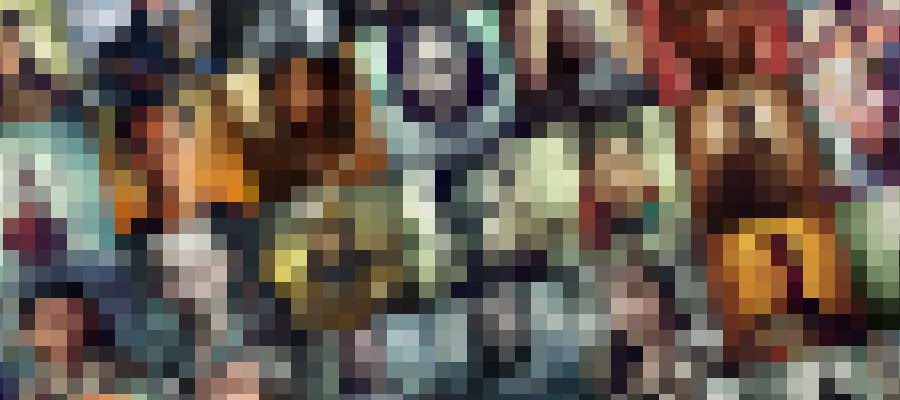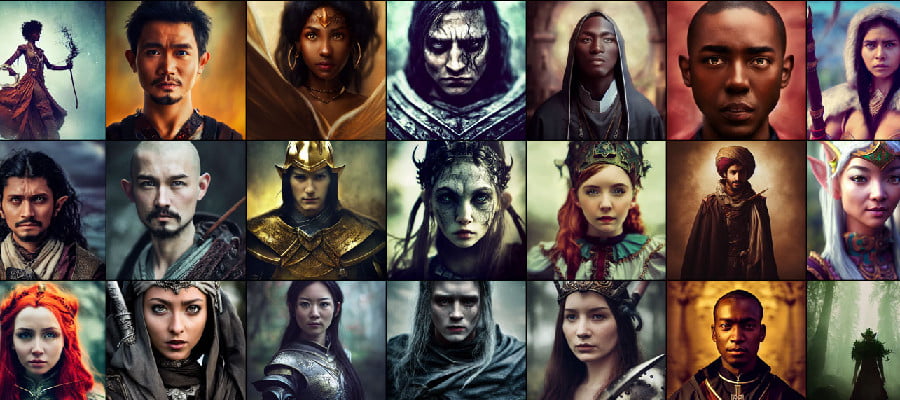As a matter of practice, it’s important to me that I keep demonstrating different ways to engage with games. Making games is a practice, and when you can look at game assets and consider ways to apply them, you’ll begin to see how much of game design is stuff you can do. Therefore, on this blog I’m making it a project to regularly grab some game assets I couldn’t make myself, that are made for game designers to work with, and see what ideas they inspire.
When I started on this project, there was something happening that I wasn’t paying that much attention to. I was aware AI art was a thing but it wasn’t something that showed up in my streams. And now we’re in this super weird position where now there’s this type of asset that’s available, cheap, affordable and in many cases being made by an interesting new type of artist, and where just engaging with them at all is going to open a giant can of worms and result in a category of people being mad at me.

This is especially fraught because I don’t think AI art is ethically free and clear but I also don’t think it’s the black spot, and that’s a conversation that has gotten people very snappy very quickly.
So, content warning: I’m going to examine an art asset pack made by an artist using an AI package and post-processed. I’m going to talk about it agnostically, addressing the art asset pack as what it is, without delving into the question of whether or not it should exist.
Cool?
Okay, here’s the asset pack:

This is Epic Fantasy RPG Icons from Infinity PBR, a itch producer that makes a lot of resources. This is just one set of a giant pile of characters, 300 portraits and I think the intention is that you can pick through them and find ones that fit for any kind of character you want to represent. They’re also AI generated, which means there are artifacts and weirdness in them, even if the creator smoothed things over. As a result, they’re better if they’re kept reasonably small.
I really like this pack especially because, as sold, it has this:
The style of this package ranges from more realistic-painterly, to photorealistic. They will appear more photoreal, and generally “better”, when at smaller resolutions. Use these for placeholder art while you prototype, for icons, buttons, backgrounds, and more.
And right! That’s a great idea, these assets can serve as good placeholders in prototype and first-draft versions of games to get them to feel serious, or to set tone. The art is a good stand-in with an understanding that bespoke art is going to be better. If nothing else, it’s going to express what you want. By definition, this art is generic. While I love creating things based on generic prompts, I recognise that that creativity is itself an exercise and it means that there’s always going to be another party involved in my production process – whoever made the assets.
I mean that’s what these brainstorms are about. They’re also about trying to see what cheap assets can become even if I don’t have anything to do with them.
But also: There’s a lot of art here.
I mean a lot of art here.
People are selling asset packs of hundreds of art assets, and it’s easy to be overwhelmed by them especially when you make games the way I make them, where (for example) you can’t fling the choosing to a computer and let that generate a component and reference the art asset. It’s an interesting quandrary of scope. Most of the games I make tend to need at best, thirty, maybe forty assets in total to build elaborate scenarios.
What’s more, this art is all contained; none of these pieces can be stitched together or have any relationship to one another beyond their general vibe. They’re themed around ‘epic fantasy’ which is to say, basically nothing, but the thing they offer you here is volume.
You know what’s a type of asset, too?
Math!
Okay, so I look at a lot of math youtube channels, and sometimes they talk about games and the ways games are designed. Matt Parker made one a few years ago about the game Dobble or Spot It, which is an interesting way that a game of a huge pile of cards with shared information form the spine of a game.
This is cool for making Dobble, but it doesn’t suit the art assets we’re looking at here, right? After all, these AI avatars are themselves kinda similar to one another, so using them as the basis of a Dobble-style game doesn’t seem to be that interesting.
Here’s the idea though:
So like, this looks like a character sheet kind of card, something you’d use for a character design based game, in a big complicated RPG style crawler game. In this case what I like is the idea that you have characters who have, well, seven attributes, and three of them are things like a class or a status or an emotional drive like a livejournal emote, and then the other four things are words like ‘driven’ or ‘regicidal’ or ‘moist’ and the idea is the entire deck is just these adventurers.
Then the question follows: What can I do with that?
If I can make it so that any given two cards have a linked attribute, then some other properties follow: Any three cards can be formed into a linked group, where cards 1 and 2 have something in common and card 3 definitely doesn’t have that trait.
Is it possible, with a dobble-style arrangement of numbers, to have tasks or quests that can be difficult to obtain or maintain? What if there’s a bunch of quests, and those quests
This dobble deck does have, secretly, suits. You can make a trick taking game out of the suits, and it’s just that every card doesn’t have a numeric value as much as it is a member of a lot of suits – seven in fact. So you could hypothetically have cards that set a value you’re trying to accumulate, and then make the game about an acquisition method. This could be about recruiting adventuring parties to send them off on raids.
One other thing that can be done here is the backs of these cards. If the front face of each card is an adventurer with seven suits, you could make it so the backs of each card represents a quest that that adventurer would be good at it, but can’t do (because they’re face-down). So the start of the game, you deal out some goals that everyone is working towards, then the game is spent acquiring the adventurers that remain to try and defeat the raids.
Am I going to pursue this one? Probably not unless one of my really smart mathfriends explains to me some other function that makes this all work because I want to spend this month polishing up other prototypes? But… it’s an interesting idea. And I dunno, for a big pile of computer-generated art, it seems appropriate to make a game concept that’s got a lot of math under the hood.

1 Trackback